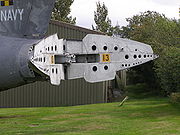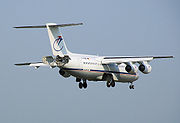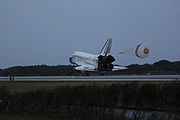.gif)
Air brake (aircraft)
Encyclopedia


Aeronautics
Aeronautics is the science involved with the study, design, and manufacturing of airflight-capable machines, or the techniques of operating aircraft and rocketry within the atmosphere...
, air brakes or speedbrakes are a type of flight control surface used on an aircraft
Aircraft
An aircraft is a vehicle that is able to fly by gaining support from the air, or, in general, the atmosphere of a planet. An aircraft counters the force of gravity by using either static lift or by using the dynamic lift of an airfoil, or in a few cases the downward thrust from jet engines.Although...
to increase drag
Drag (physics)
In fluid dynamics, drag refers to forces which act on a solid object in the direction of the relative fluid flow velocity...
or increase the angle of approach during landing.
The earliest known air brake was developed in 1931 and deployed on the wing support struts. Not long after air brakes located on the bottom of the wing's trailing edge were developed and became the standard type of aircraft air brake for decades.
Air brakes differ from spoilers
Spoiler (aeronautics)
In aeronautics, a spoiler is a device intended to reduce lift in an aircraft. Spoilers are plates on the top surface of a wing which can be extended upward into the airflow and spoil it. By doing so, the spoiler creates a carefully controlled stall over the portion of the wing behind it, greatly...
in that air brakes are designed to increase drag
Drag (physics)
In fluid dynamics, drag refers to forces which act on a solid object in the direction of the relative fluid flow velocity...
while making little change to lift
Lift (force)
A fluid flowing past the surface of a body exerts a surface force on it. Lift is the component of this force that is perpendicular to the oncoming flow direction. It contrasts with the drag force, which is the component of the surface force parallel to the flow direction...
, whereas spoilers reduce the lift-to-drag ratio and require a higher angle of attack
Angle of attack
Angle of attack is a term used in fluid dynamics to describe the angle between a reference line on a lifting body and the vector representing the relative motion between the lifting body and the fluid through which it is moving...
to maintain lift, resulting in a higher stall
Stall (flight)
In fluid dynamics, a stall is a reduction in the lift coefficient generated by a foil as angle of attack increases. This occurs when the critical angle of attack of the foil is exceeded...
speed. Most gliders
Glider aircraft
Glider aircraft are heavier-than-air craft that are supported in flight by the dynamic reaction of the air against their lifting surfaces, and whose free flight does not depend on an engine. Mostly these types of aircraft are intended for routine operation without engines, though engine failure can...
are equipped with air brakes on the wings to adjust their angle of descent during approach to landing.
Often, characteristics of both spoilers and air brakes are desirable and are combined - most modern airliner
Airliner
An airliner is a large fixed-wing aircraft for transporting passengers and cargo. Such aircraft are operated by airlines. Although the definition of an airliner can vary from country to country, an airliner is typically defined as an aircraft intended for carrying multiple passengers in commercial...
jets feature combined spoiler and air brake controls. On landing, the deployment of these spoilers causes a dramatic loss of lift and hence the weight of the aircraft is transferred from the wings to the undercarriage, allowing the wheels to be mechanically braked with much less chance of skidding. In addition, the form drag created by the spoilers directly assists the braking effect. Reverse thrust is also used to help slow the aircraft after landing.
The British Blackburn Buccaneer
Blackburn Buccaneer
The Blackburn Buccaneer was a British low-level subsonic strike aircraft with nuclear weapon delivery capability serving with the Royal Navy and the Royal Air Force between 1962 and 1994, including service in the 1991 Gulf War...
naval strike aircraft designed in the 1950s had a tail cone that was split and could be hydraulically opened to the sides to act as a variable air brake. It also helped to reduce the length of the aircraft in the confined space on an aircraft carrier.
The F-15 Eagle
F-15 Eagle
The McDonnell Douglas F-15 Eagle is a twin-engine, all-weather tactical fighter designed by McDonnell Douglas to gain and maintain air superiority in aerial combat. It is considered among the most successful modern fighters with over 100 aerial combat victories with no losses in dogfights...
, Sukhoi Su-27
Sukhoi Su-27
The Sukhoi Su-27 is a twin-engine supermanoeuverable fighter aircraft designed by Sukhoi. It was intended as a direct competitor for the large United States fourth generation fighters, with range, heavy armament, sophisticated avionics and high manoeuvrability...
and other fighters have an air brake just behind the cockpit.
Split control surfaces
The deceleronDeceleron
A deceleron, or split aileron, was developed in the late 1940s by Northrop originally for use on the F-89 Scorpion fighter aircraft. It is a two-part aileron that can be deflected as a unit to provide roll control, or split open to act as an air brake. Decelerons are also used on the Fairchild...
is an aileron
Aileron
Ailerons are hinged flight control surfaces attached to the trailing edge of the wing of a fixed-wing aircraft. The ailerons are used to control the aircraft in roll, which results in a change in heading due to the tilting of the lift vector...
that functions normally in flight but can split in half such that the top half goes up as the bottom half goes down to brake. This technique was first used on the F-89 Scorpion
F-89 Scorpion
The Northrop F-89 Scorpion was an early American jet-powered fighter designed from the outset as an all-weather interceptor. Though its straight wings limited its performance, it was among the first USAF jet fighters with guided missiles, and notably the first combat aircraft armed with air-to-air...
and has since been used by Northrop
Northrop Corporation
Northrop Corporation was a leading United States aircraft manufacturer from its formation in 1939 until its merger with Grumman to form Northrop Grumman in 1994. The company is known for its development of the flying wing design, although only a few of these have entered service.-History:Jack...
on several aircraft, including the B-2 Spirit
B-2 Spirit
The Northrop Grumman B-2 Spirit is an American heavy bomber with low observable stealth technology designed to penetrate dense anti-aircraft defenses and deploy both conventional and nuclear weapons. The bomber has a crew of two and can drop up to eighty -class JDAM GPS-guided bombs, or sixteen ...
.

Space Shuttle
The Space Shuttle was a manned orbital rocket and spacecraft system operated by NASA on 135 missions from 1981 to 2011. The system combined rocket launch, orbital spacecraft, and re-entry spaceplane with modular add-ons...
uses a similar system. The split rudder opens on landing to act as a speed brake, http://science.ksc.nasa.gov/shuttle/technology/sts-newsref/sts_coord.html#vertical_tail as shown in the accompanying photo.

